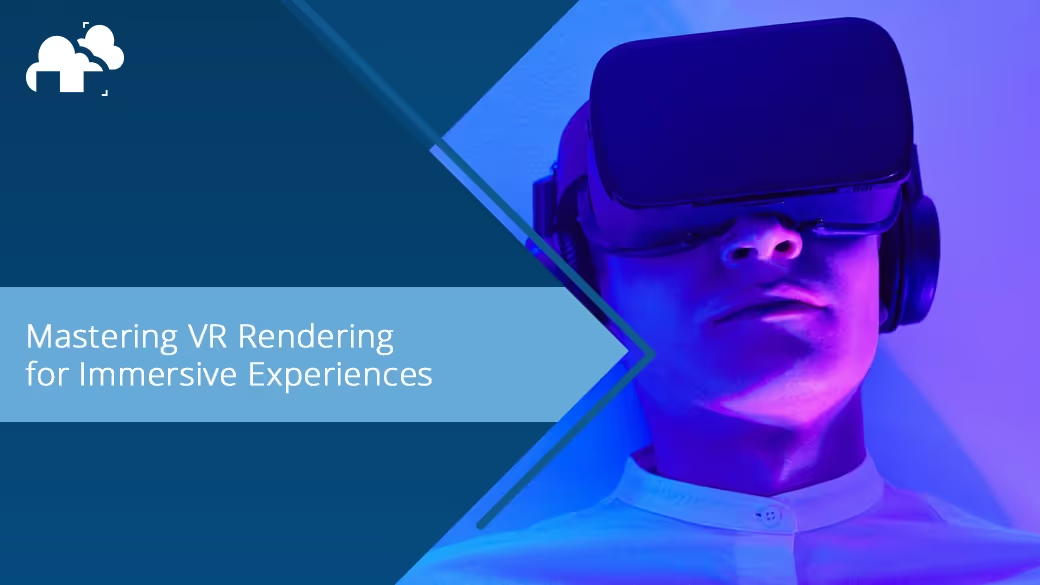
Virtual Reality (VR) has revolutionized how we interact with digital environments. From architectural walkthroughs to immersive gaming, VR is pushing boundaries in visualization and interactivity. But behind every seamless experience lies a demanding process: VR rendering. In this article, we’ll unpack what VR rendering really means, explore its unique challenges, and guide you through optimizing your VR workflows, whether you're targeting devices like the Meta Quest 3 or desktop-grade setups like the HTC Vive.
At its core, VR rendering refers to the process of generating stereoscopic 3D images for each eye in real time, tailored specifically for viewing through a virtual reality headset. Unlike traditional rendering where a single camera view is sufficient, VR demands two (one for each eye) creating a convincingly immersive stereoscopic experience. This dual-camera system dramatically increases the rendering workload. But it’s essential: the moment latency creeps in or frame rates drop below 72 Hz (ideally 90 Hz or more), the user’s sense of immersion breaks. Worse still, it can trigger motion sickness.
Unlike a flat screen, where a single frame is rendered per refresh cycle, VR requires two images simultaneously, each mimicking the human eye’s perspective. This stereo output effectively doubles the rendering demand. Combine that with the need for buttery-smooth motion, and you’re looking at a performance requirement that outpaces even the most demanding AAA games.
VR headsets like the Meta Quest 3 or HTC Vive offer wide fields of view, often around 100 degrees or more. Rendering across such a viewport at high resolution ensures the user doesn’t see a pixelated world. However, this significantly increases GPU load.
Minor delays between user input (such as moving one’s head) and image response can cause discomfort to the user. The rendering pipeline must be optimized to reduce latency to imperceptible levels. That means carefully managing everything from scene complexity to shading and post-processing.
Let’s break down a typical VR rendering workflow using popular tools like Blender, Unity, or Unreal Engine, with outputs tailored for headsets running on Meta Horizon OS or SteamVR.
Whether you’re working in Blender, SketchUp, or Autodesk Revit, it’s important to start with a clear understanding of scale and spatial ergonomics. Users will physically move through your environment, so proportions must match real-world expectations. Common objects like doors, railings (or even balusters), and stairs should feel natural and correctly sized. When the object is too big or too small, it can feel weird for the user or break the realism of the VR world.
If you would like to render a 360 degree or stereoscoping render, you can also do this through your chosen software. In Blender’s Cycles, for example, this is done by checking stereoscopy in the output properties tab and select Stereo 3D for the views format, and stereo mode to Top-Bottom. Afterwards, go into your camera properties and make the type to panoramic, and the panoramic type to equirectangular. Before hitting render, be sure to also check the spherical stereo box.
Textures must be consistent in clarity across objects to avoid breaking immersion. This is where Texel Density comes into play. Uniform texel density ensures that no object appears oddly blurry or overly sharp compared to its surroundings. Use add-ons like Texel Density Checker in Blender to maintain consistent pixels-per-meter across your assets. Proper UV mapping and efficient use of texture space (e.g., through UDIMs or shared UV grids) also minimize GPU workload while preserving image fidelity.
Real-time lighting is often a performance hog. In VR, you need to strike a balance between visual fidelity and real-time responsiveness.
When developing 3D scenes for VR, your render needs to respect the limits of your target hardware. No matter the device, performance is king, and visual fidelity must be strategically balanced against it. Ultimately, the goal is to deliver immersive, visually compelling scenes that run smoothly across a range of hardware. Intelligent asset management, efficient lighting strategies, and constant performance testing are your best allies in achieving that balance.
Start by minimizing polygon counts. Even modestly complex environments can become performance hogs if mesh density isn’t kept in check. Use Level of Detail (LOD) systems to dynamically swap in lower-resolution versions of assets based on their distance from the viewer. This reduces computational load without visibly sacrificing quality.
Textures should be compressed and sized appropriately for their use. Avoid loading 4K textures for small props and opt instead for streamlined assets and smart texture reuse. Likewise, real-time shadows and reflections are among the most performance-costly features. Consider baking lighting wherever possible and use tricks like ambient occlusion maps and light probes to simulate depth and softness without burdening the GPU.
GPU profiling tools can be invaluable here. Whether you’re hitting frame rate walls due to shader complexity, z-buffer overdraw, or excessive framebuffer effects like motion blur, diagnosing your bottlenecks early lets you optimize where it matters most.
Tools like Enscape and Twinmotion allow direct visualization of BIM models from platforms like Revit, Vectorworks, and Archicad inside VR. The key here is ensuring your assets are ready:
For architectural and design firms, integrating VR into their design process has elevated client communication, allowing for walkthroughs, real-time design iteration, and spatial understanding that traditional renders or videos can’t match.
As GPUs evolve and real-time ray tracing becomes more viable for VR, we’re heading toward a future where photorealism and real-time interaction merge seamlessly. Technologies like deferred shading, AI-driven upscaling, and even cloud-rendered VR (where scenes are processed on remote GPUs and streamed to headsets) are redefining what's possible.
VR rendering isn’t just about getting images into a headset, it’s about crafting an experience that feels real, intuitive, and impactful. Whether you’re creating architectural walkthroughs, virtual product demos, or immersive art installations, the key is balancing visual fidelity with performance. By mastering the fundamentals such as texel density, shading, stereo rendering, and workflow optimization, and by understanding your target hardware, you can bring compelling virtual spaces to life. So go ahead and render your reality.